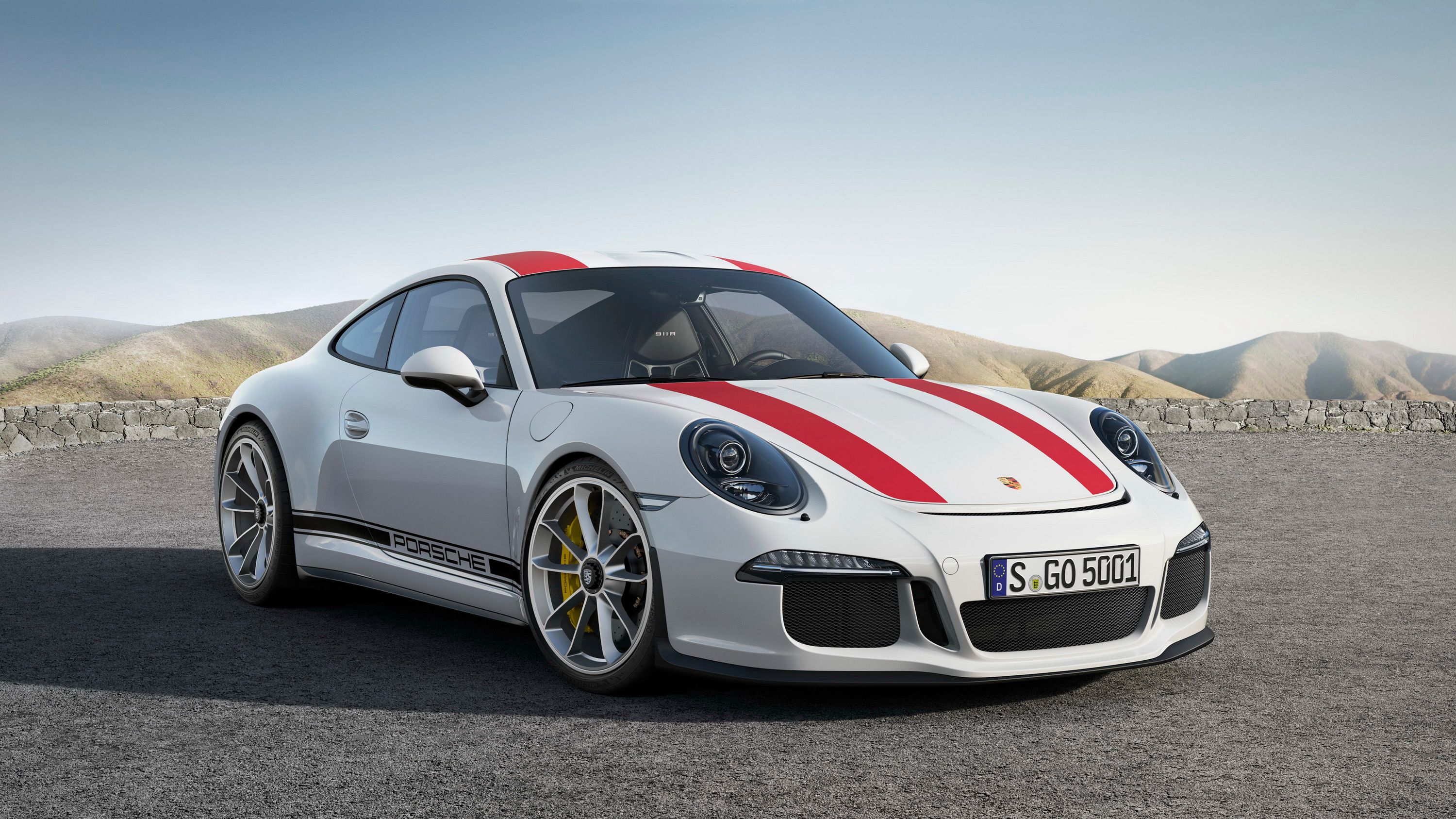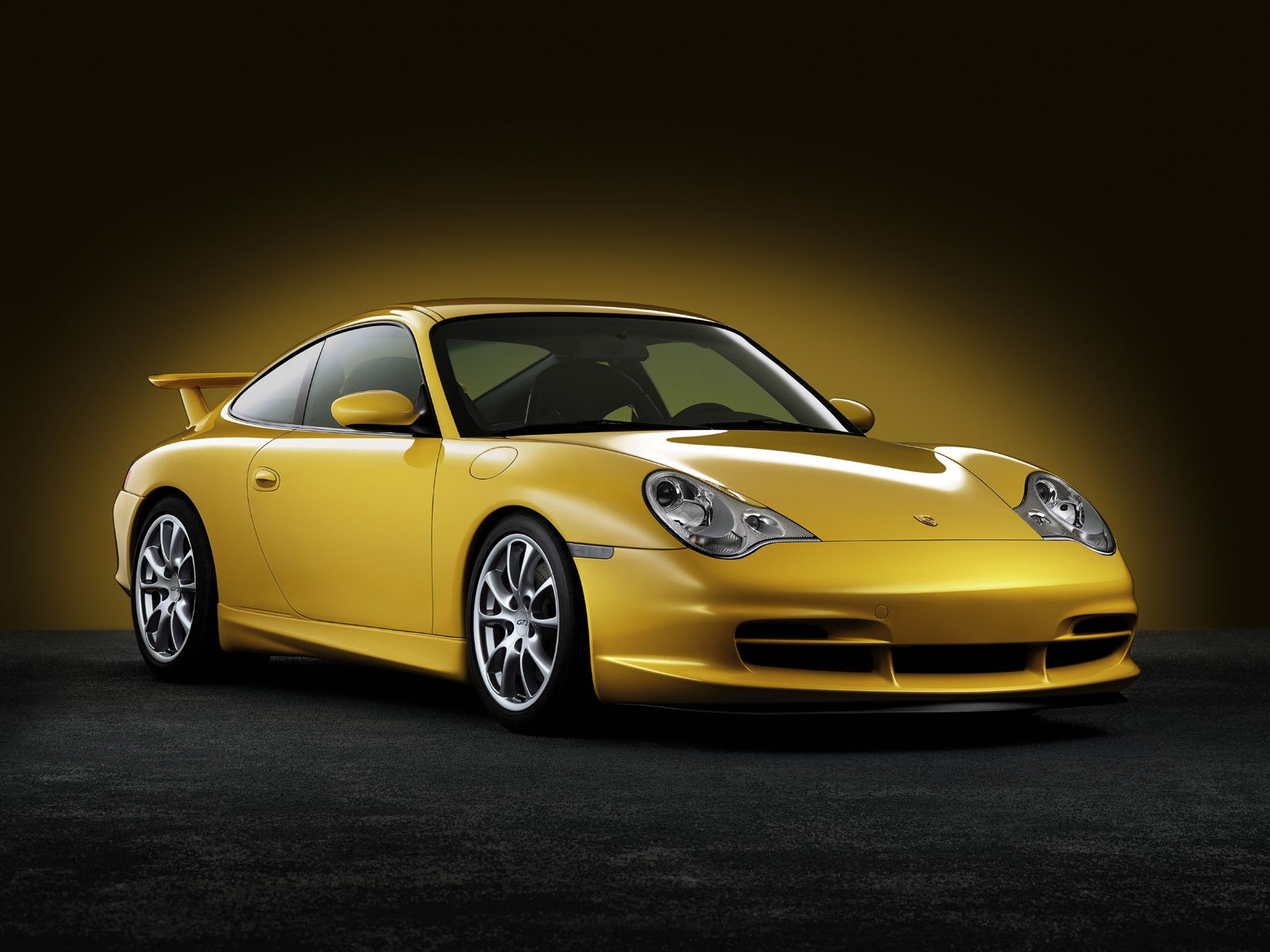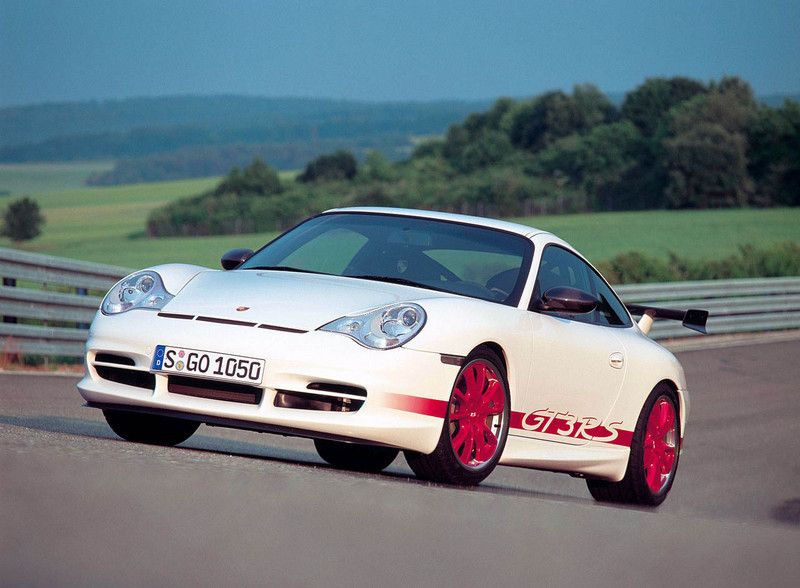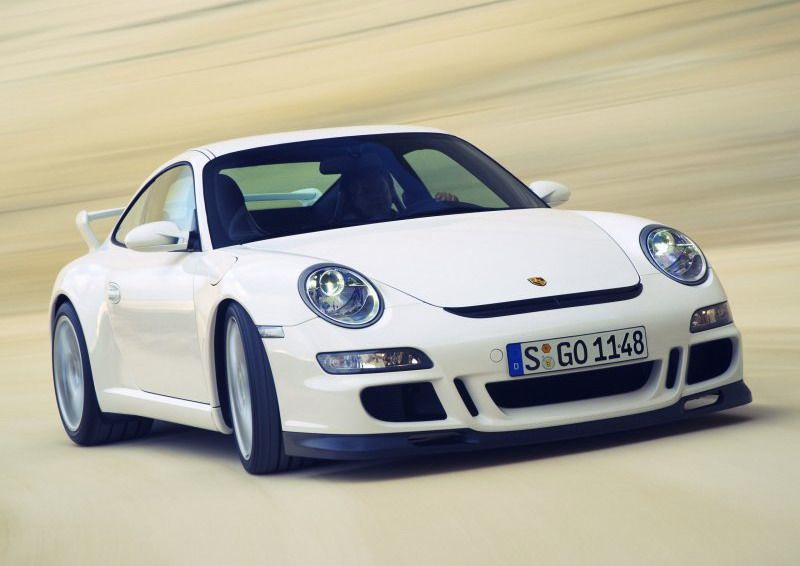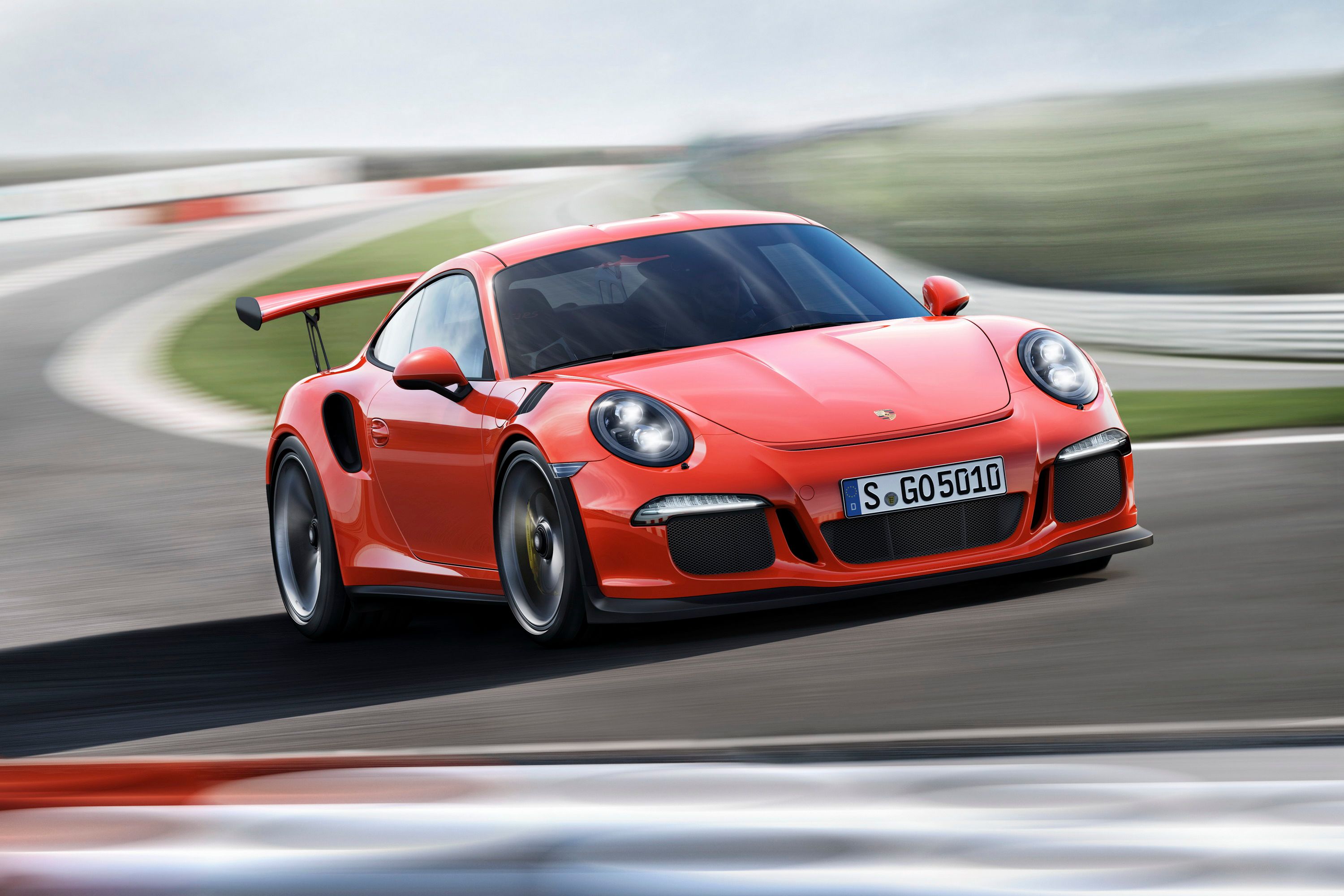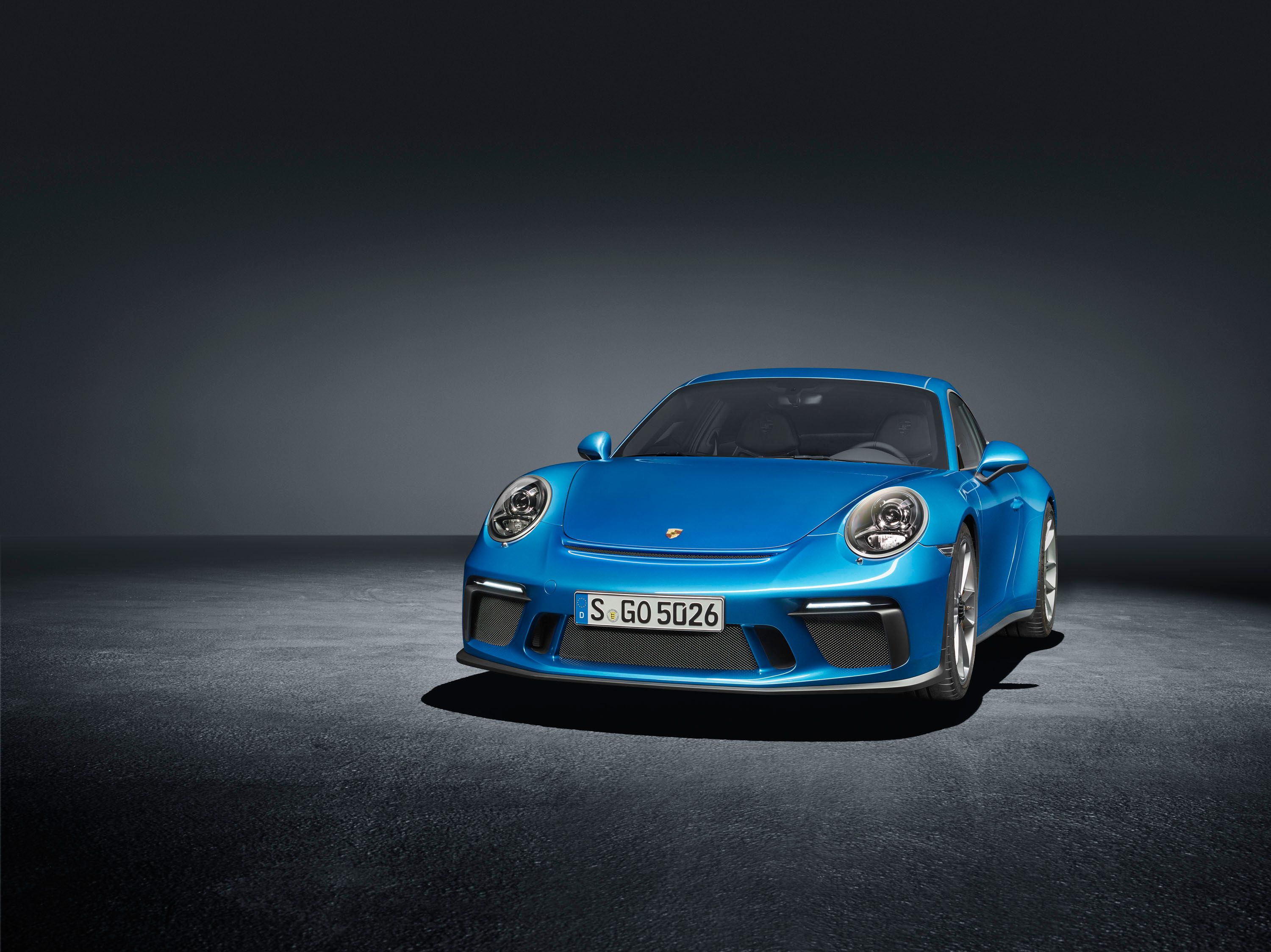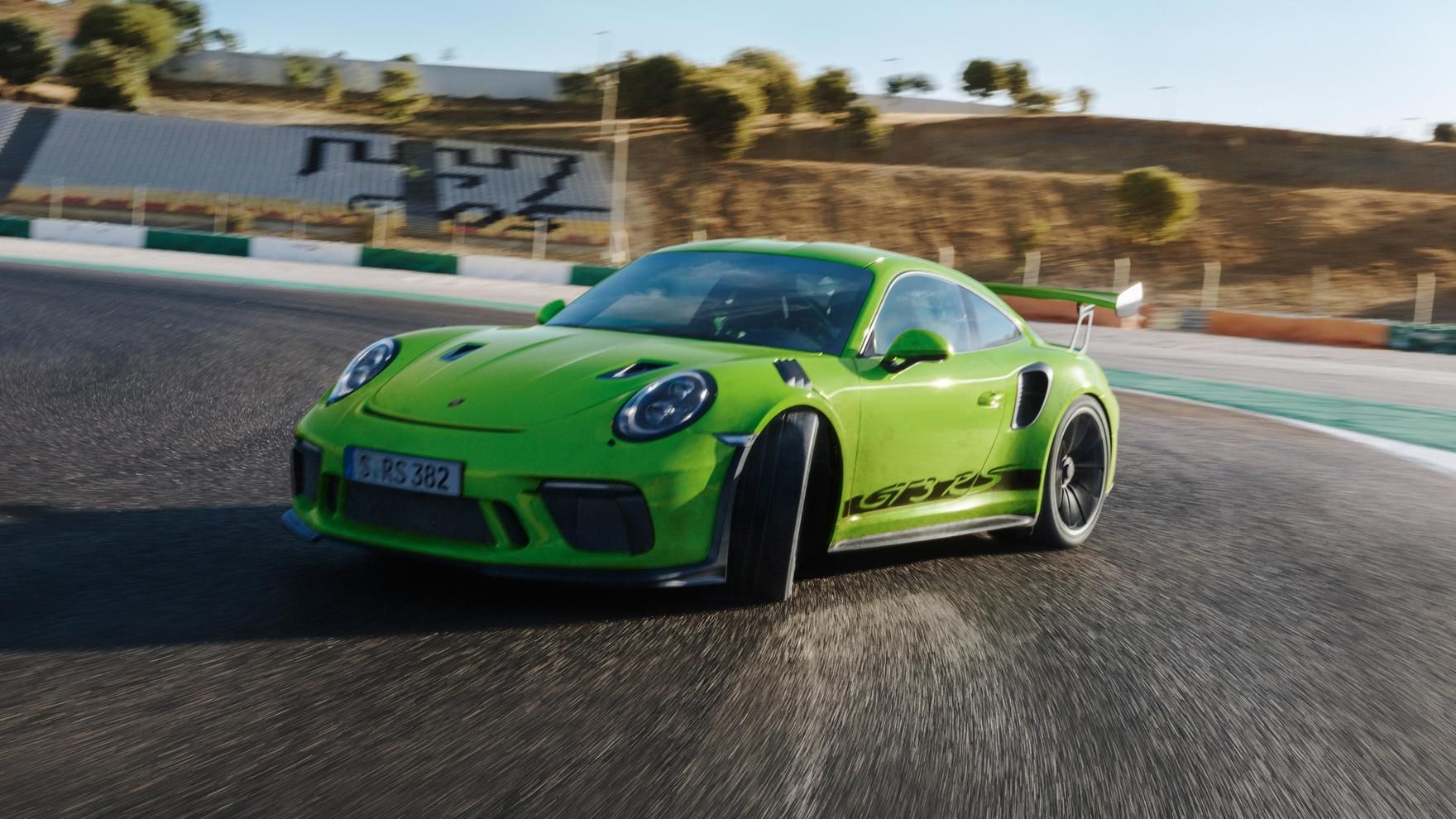Porsche is known for continuously bringing race-bred technology into its road cars. The Stuttgart-based manufacturer that has been perfecting the rear-engine formula for over five decades now is also famous for its homologation specials, road-worthy counterparts built by Porsche to race thoroughbred competition machinery in production-based classes of sports car racing. 20 years ago, Porsche introduced the latest model that would spawn a myriad of racing versions: the Porsche 911 GT3, a track-oriented 911 that could be used as a daily driver (if you dared). It came at the same time as the not-for-the-purist 996 generation but, in spite of this, can you now imagine a world without the 911 GT3 in it?
Where were you in 1999 when Porsche unveiled the 996.1-generation Porsche 911 GT3? Well, you probably weren't at the Geneva Auto Show where Porsche took the wraps of what was, in essence, the road-legal version of the newest Porsche 911 Cup car that would compete in the Porsche Carrera Cup Germany and later in the Porsche Supercup sharing the bill with the Formula 1 World Championship. The first 911 GT3 looked a bit tame but, as years rolled by, it evolved, growing bigger, more aggressive, and more insane and overshadowed with ease the 911 GT2, a model we originally thought it'd replace before Porsche decided to continue making GT2 models, somewhat as even more extreme versions of the 911. This is the story of the GT3, a model more famous than all of the track-focused 911s that have come before it, even the Carrera RS 2.7 of 1973.
Life Before the Porsche 911 GT3
The first Porsche 911, originally known as the 901 (since the internal project name was Typ 901) was launched at the 1963 Frankfurt Auto Show as the replacement for the long-standing 356. The 911 was a brand-new car on the outside with a body designed by Ferdinand 'Butzi' Porsche some four years earlier but some of the mechanical aspects had been tried and tested on the 356 platform. One of these was the engine, a 2.0-liter unit. While it was new in itself, it was still a boxer as seen on the 356s and was air-cooled with an output in the region of 130 horsepower.
Still, that early success of the new 911 platform, coupled with Eberhard Mahle run of good results in the European Hillclimb Championship, prompted engineers at Zuffenhausen to look into the possibility of upgrading the 911 for racing purposes. Rolf Wuetherich, James Dean's mechanic who miraculously survived the horrifying crash that took the life of the famous actor in 1955, underlined what a 911 in race trim should achieve: a better power-to-weight ratio than its competitors with engines of the same capacity. That result was achieved with the first 911 R mule that was tested in the autumn of 1966. Its 210-horsepower engine only had to move 1,763 pounds, so the criteria was met.
Six years down the line, towards the tail end of the production of what's considered to be the classic 911, the first generation of the legend, Porsche finally decided to up the ante and build a proper car for the Group 4 class (not the Group 4 prototype class where the 906 had competed, but the Group 4 class for GT cars). Still, the requirement from the FISA was the same: build 500 units and you can go racing. Porsche was racing in this category with modified versions of the 911 S and the 911 T as it'd made enough of those to homologate them for competition. But Ferrari's 356 GTB4 in 'Competizione' trim was leaving these cars in a cloud of dust in 1972 when it debuted as the racing version of the world's fastest car. Porsche competed in a lower class within Gr. 4 (based on engine size) but the guys back in Stuttgart still didn't like to get their asses handed to them like that so the Carrera 2.7 RS was developed.
The 'Carrera RS' nameplate would return, for instance with the not-for-the-faint-hearted 964 Carrera RS, a car that was as close to the version you'd see banging fenders and doors in the German Carrera Cup that you could even option it with a nearly identical roll-bar inside. The Carrera RS was, however, road-legal but you had to be really cautious with it as it had basically no downforce (all you had was mechanical grip from the thick rubber) and was properly unruly even in the dry. In 1995, the replacement for the 964-generation RS arrived in the form of the 993-generation RS.
That 3.8-liter engine was 0.2-liters bigger than the engine on the standard 993 Carrera and was mighty powerful: 296 horsepower and 262 lb-ft of torque that had to motivate 2,821 pounds - over 300 pounds less than the last of the 991-based GT3 RSs. The Carrera RS remained raw and unforgiving although a ducktail returned over the engine lid and it helped keep the rear in place just a bit. Barely 1,000 units were made between 1995 and 1996 and none were originally sold in the U.S.
Coincidentally, along with the final Carrera RS, Porsche also dropped in 1995 a 911 that was even more extreme: the first GT2. The name stemmed from the fact that it was built to compete in the GT2 class of the same BPR Global GT Championship (the Carrera RS would compete in the GT3 and GT4 class - although this arrangement got mixed up as the organizers changed their minds often over which cars went where). The GT2 came with a 3.6-liter unit but what it lacked in displacement over the Carrera RS it made up in forced induction as the engine received a pair of turbochargers that pushed the output all the way to 424 horsepower (and then to 444 horsepower in 1998).
It featured a bi-plane rear wing, an enormous splitter in the front with an air tunnel-shaped lip that curved upwards around the sides of the nose. Top speed was 190 mph and the dash from 0 to 60 mph took just four seconds. The racing version was dominant, continuing to race in the top GT-based class (after the mad prototype-like GT1 class of 1997-1998 came down in flames due to massive costs) even as the factory had introduced the 996-based GT3 for the lower categories.
What Zuffenhausen wanted to do with the GT3 was take the spirit of the GT2 and the Carrera RS that preceded it and make it a bit more friendly, a bit more relaxed, so that even a more casual driver could enjoy it without ending up in the ER sooner rather than later.
2000-2003 Porsche 996.1 GT3
The first Porsche 911 GT3 arrived as a statement for customers: Porsche was now mature enough to offer a product that, while rooted in the world of motorsports, was civilized enough to be driven around town with ease, controls so swift that even your granny could wrap her head around the basics of driving a GT3 before you could say 'Mezger'.
But those that ignored the questionable move in design found out that the 996.1 GT3 (known also as the Ur-GT3) was a wonderful and potent car: packing the 3.6-liter, water-cooled Mezger flat-six with 355 horsepower on tap at 7,200 rpm, the first GT3 could lap the Nordschleife in under eight minutes - provided a guy like Walter Röhrl was around to do the driving. While the aerodynamic package can be considered mild at best by today's standards, that Mezger unit was related to the one powering the winner of the 24 Hours of Le Mans, the amazing 911 GT1-98, while the six-speed manual gearbox originated from the Porsche 911 (993) GT2. It spawned the 911 GT3-R that debuted the same year as the road car and then the GT3 RS.
2000-2003 PORSCHE 996.1 GT3 specifications
|
Engine: |
3.6-liter, water-cooled, flat-six, DOHC, compression ratio of 11.7:1 |
|---|---|
|
Output: |
355 horsepower at 7,200 rpm |
|
Torque: |
273 pound-feet of torque at 5,000 rpm |
|
Gearbox: |
Six-speed manual |
|
Brakes: |
Ventilated discs all around, 12.9 inches in diameter in the front and 11.8 inches in diameter in the rear |
|
Suspension: |
Monotube with coilovers in the front and multi-link in the back, adjustable anti-roll bars all around |
|
Steering: |
assisted rack & pinion |
|
Performance: |
0-60 mph 4.8 seconds |
|
Top speed: |
188 mph |
|
Weight: |
2,976 pounds |
Read our full review on the 2000-2003 Porsche 996.1 GT3
2004-2005 Porsche 996.2 GT3
While 1,858 units of the 996.1 GT3 were made before the 996.2 stepped in, it never made it to the States. With the public's appetite whet, there was a desire for more. When the 996 generation received its mid-life upgrade, the GT3 followed suit and the 996.2 GT3 debuted in 2003. Along with the stylistic changes (like the remodeled headlights and intakes, as well as a different rear wing) came a boost in engine output: from 355 horsepower to 381 horsepower at 7,400 rpm (and 284 pound-feet of twist). U.S. finally got the GT3 for the 2004 MY.
2004-2005 PORSCHE 996.2 GT3 specifications
|
Engine: |
3.6-liter, water-cooled, flat-six, DOHC, compression ratio of 11.7:1 |
|---|---|
|
Output: |
381 horsepower at 7,400 rpm |
|
Torque: |
284 pound-feet of torque at 5,000 rpm |
|
Gearbox: |
six-speed manual |
|
Suspension: |
Monotube with coilovers in the front and multi-link in the back, adjustable anti-roll bars all around |
|
Brakes: |
Ventilated disc brakes all around, ceramic brakes optional |
|
Steering: |
Assisted rack & pinion |
|
Performance: |
0-60 mph in 4.3 seconds |
|
Top Speed: |
190 mph |
|
Weight: |
3,042 pounds |
Read our full review on the 2004-2005 Porsche 996.2 GT3
2003-2005 Porsche 996 GT3 RS
2003 was an important year because Porsche decided to revive the 'RS' badge and stick it on the back of the 996.2 GT3.
The dampers are stiffer, the front and rear control arms are adjustable, the window in the back (and the rear-quarter windows) are made out of polycarbonate to shave off some more weight and the bigger wing that hangs over the engine lid is made out of carbon fiber. The end result? 110 pounds down on weight. And a thrilling driving experience that makes the first GT3 RS a collector's must-have with prices soaring past the $250,000 mark.
2003-2005 PORSCHE 996 GT3 RS specifications
|
Engine: |
3.6-liter, water-cooled, flat-six, DOHC, 24-valve |
|---|---|
|
Output: |
381 horsepower at 7,400 rpm |
|
Torque: |
284 pound-feet of torque at 5,000 rpm |
|
Gearbox: |
six-speed manual with limited-slip differential |
|
Suspension: |
Monotube with coilovers in the front and multi-link in the back, adjustable anti-roll bars all around, adjustable control arms, stiffer progressive dampers |
|
Brakes: |
Ventilated discs all around, 13.7 inches in diameter in the front with six-piston calipers and 13.7 inches in diameter in the rear with four-piston calipers |
|
Steering: |
Assisted rack & pinion |
|
Weight: |
2,998 pounds |
Read our full review on the 2003-2005 Porsche 996 GT3 RS
2007 - 2009 Porsche 997.1 GT3
In 2005, Porsche gave the 911 its round eyes back but something else remained the same: the GT3 that came in 2006 was still built starting from the narrow body of the Carrera.
The claimed top speed was 193 mph while a run from naught to 60 mph took just 4.1 seconds. It also stopped quicker thanks to bigger tires, bigger brakes. And there was even an electronically controlled exhaust. As expected, the phenomenon that was the GT3 kept gaining momentum and almost 2,400 units were sold until 2009 when the GT3 celebrated its 10th birthday.
2007 - 2009 PORSCHE 997.1 GT3 specifications
|
Engine: |
3.6-liter, water-cooled, DOHC, 24-valve, flat-six |
|---|---|
|
Output: |
409 horsepower at 7,600 rpm |
|
Torque: |
299 pound-feet of torque at 5,500 rpm |
|
Gearbox: |
six-speed manual |
|
Suspension: |
Coilovers over adjustable dampers and anti-roll bars, multi-link in the back |
|
Brakes: |
Discs all around, 14.9 inches in diameter in the front and 13.7 inches in the rear |
|
Steering: |
Assisted rack & pinion |
|
Weight: |
3,075 pounds |
Read our full review on the 2007 - 2009 Porsche 997.1 GT3
2008-2009 Porsche 997.1 GT3 RS
We seem to always pick the short straw.
As was the case with the 996.2 model, power did not go up but the RS was quicker on a track at all times (it posted a sub-two-minute lap time on the full-length Hockenheim GP track) and would complete a quarter-mile run in 12 seconds flat.
2008-2009 PORSCHE 997.1 GT3 RS specifications
|
Engine: |
3.6-liter, water-cooled, DOHC, 24-valve, flat-six |
|---|---|
|
Output: |
409 horsepower at 7,600 rpm |
|
Torque: |
299 pound-feet of torque at 5,500 rpm |
|
Gearbox: |
six-speed manual |
|
Suspension: |
Coilovers over adjustable dampers and anti-roll bars, multi-arm in the back |
|
Brakes: |
Discs all around |
|
Steering: |
Assisted rack & pinion |
|
Weight: |
3,031 pounds |
Read our full review on the 2008-2009 Porsche 997.1 GT3 RS
2010-2011 Porsche 997.2 GT3
The 997.2 GT3 was the first to feature a bigger engine as the 3.6-liter unit grew to 3.8-liters (and compression ratio was now 12.2:1). This meant both power and torque went up too: all the way to 435 horsepower and 317 pound-feet.
All these updates allowed the 997.2 GT3 to lap the Nordschleife in a then scarcely-believable 7:40 minutes. That's also in part thanks to the reshaped rear wing that worked with the new splitter and better diffuser to return almost twice the downforce figures of its predecessor. 0-60 mph took just four seconds flat but the top speed barely went up by 1 mph to 194 mph. Happily, there was room for more - so much more.
2010-2011 PORSCHE 997.2 GT3 specifications
|
Engine: |
3.8-liter, water-cooled, naturally aspirated flat-six |
|---|---|
|
Output: |
435 Horsepower at 7600 rpm |
|
Torque: |
317 pound-feet of torque at 6,250 rpm |
|
Gearbox: |
six-speed manual |
|
Suspension: |
Front axle in McPherson design, cylindrical springs with inner-mounted dampers, fully controlled single-sleeve gas-pressure damper units (PASM), and in the rear multi-arm with coil springs, inner-mounted dampers, fully controlled single-sleeve gas-pressure damper units (PASM) |
|
Steering: |
Assisted rack & pinion |
|
Performance: |
0-60 mph in 4.0 seconds |
|
Top speed: |
194 mph |
|
Weight: |
3,076 pounds |
Read our full review on the 2010-2011 Porsche 997.2 GT3
2010-2012 Porsche 911 GT3 RS
The 997.2 GT3 RS is the first GT3 RS to come with more power than the standard GT3 model. A boost in compression sees 15 ponies added to the total that now reaches a round value: 450 horsepower. The transmission's ratios are shorter (with shorter throws, too).
Porsche made 1,500 units of these and they didn't sell as quickly as Porsche had anticipated - effectively making Zuffenhausen cap the production number of future GT3 RS models as well as other special models (the company was doing it already at the time anyway with the 997.2 GT2 RS or the Speedster). The next limited-edition model was a surprise: a final bow of the 997 generation: the 4.0.
2010-2012 PORSCHE 911 GT3 RS specifications
|
Engine: |
3.8-liter, water-cooled, naturally aspirated flat-six |
|---|---|
|
Output: |
450 Horsepower at 7,600 rpm |
|
Torque: |
317 pound-feet of torque at 6,250 rpm |
|
Gearbox: |
six-speed manual |
|
Brakes: |
Discs all around |
|
Suspension: |
Front axle in McPherson design, cylindrical springs with inner-mounted dampers, fully controlled single-sleeve gas-pressure damper units (PASM), and in the rear multi-arm with coil springs, inner-mounted dampers, fully controlled single-sleeve gas-pressure damper units (PASM) |
|
Steering: |
Assisted rack & pinion |
|
Performance: |
0-60 mph in 3.8 seconds |
|
Top speed: |
193 mph |
|
Weight: |
3,026 pounds |
Read our full review on the 2010-2012 Porsche 911 GT3 RS
2011-2012 Porsche 911 997.2 GT3 RS 4.0
The 4.0 was meant to be a collectible straight from the showroom floor: with 0.2 liters extra and bits taken straight from the GT2-spec GT3 RSR, the 997.2 GT3 RS 4.0 cranked out 500 horsepower and 339 pound-feet of torque. In spite of the power hike, it wasn't quicker to 60 mph nor was it faster at the end of sixth gear compared to a 3.8-liter Mark II 997 GT3 RS.
Underneath the flashy livery, there was carbon fiber for the front fenders and the trunk lid. The interior was even more sporty and the weight was kept just below the 3,000-pound mark. Production was capped to just 600 units making it the most desirable water-cooled modern Porsche ever made. Of course, this title was whiskered away in no time by the 997.2 GT2 RS but what matters is that the 4.0 commands now pretty hefty prices that exceed $500,000 at times. Sadly, with these beasts being as rare as they are, not many get to be driven as much as they should be.
2011-2012 PORSCHE 911 997.2 GT3 RS 4.0 specifications
|
Engine: |
4.0-liter, water-cooled, naturally aspirated flat-six |
|---|---|
|
Output: |
500 Horsepower at 8,250 rpm |
|
Torque: |
339 pound-feet of torque at 5,750 rpm |
|
Gearbox: |
six-speed manual |
|
Brakes: |
Discs all around |
|
Suspension: |
Front axle in McPherson design, cylindrical springs with inner-mounted dampers, fully controlled single-sleeve gas-pressure damper units (PASM), and in the rear multi-arm with coil springs, inner-mounted dampers, fully controlled single-sleeve gas-pressure damper units (PASM) |
|
Steering: |
Assisted rack & pinion |
|
Performance: |
0-60 mph in 3.8 seconds |
|
Top speed: |
193 mph |
|
Weight: |
2,998 pounds |
Read our full review on the 2011-2012 Porsche 911 997.2 GT3 RS 4.0
2014-2016 Porsche 991.1 GT3
The 991.1 GT3 can be seen as the tipping point: no difference in width between the standard GT3 and the RS, no 'Mezger' flat-six under the hood, and, finally, no six-speed manual. Instead, the boxer in the back was vaguely related to that in the 991.1 Carrera S while the gearbox was of the PDK type - faster on the track, helping the 991.1 to outpace the 997.2 despite it being heftier (but the manual returned as an option on the 991.2 GT3).
2014-2016 PORSCHE 991.1 GT3 specifications
|
Engine: |
3.8-liter, water-cooled, naturally aspirated, flat-six, 13.3:1 compression ratio |
|---|---|
|
Output: |
475 hp at 8,250 rpm |
|
Torque: |
324 pound-feet at 6,250 rpm |
|
Gearbox: |
dual-clutch PDK seven-speed automatic with flappy paddles |
|
Brakes: |
Steel ventilated discs all around with six-rotor calipers in the front and four-rotor calipers in the back |
|
Suspension: |
MacPherson strut suspension with anti-roll bar in the front and LSA multi-link suspension with anti-roll bar in the back with PSM |
|
Steering: |
assisted rack & pinion |
|
Performance: |
0-60 mph in 3.5 seconds |
|
Top speed: |
195 mph |
|
Weight: |
3,153 pounds |
Read our full review on the 2014-2016 Porsche 991.1 GT3
2016-2017 Porsche 991.1 GT3 RS
The 991.1 GT3 RS is maybe the RS that's been modified the most in comparison to the standard version: it features a remodeled nose, more air inlets, a vastly bigger wing, vents over the fenders, and it's also lighter. Also, the engine's capacity is bigger: 4.0-liters (but unrelated to the mill in the 997.2 GT3 RS 4.0). Power went from 475 horsepower to 500 horsepower (as much as the 991.2 GT3, actually) but there was no manual.
A lap of the Northern Loop of the Nürburgring is completed by a 991.1 GT3 RS in just 7 minutes and 20 seconds despite the fact that the car is slower by 2 mph than the standard GT3 due to the more aggressive aero package with the bigger lip in the front, the bigger diffuser, and the fixed carbon-fiber wing. Rear-wheel steering, an active limited-slip differential (for PDK), torque vectoring, and adaptive suspension were all standard on this model but the carbon-ceramic brakes were not.
2016-2017 PORSCHE 991.1 GT3 RS specifications
|
Engine: |
4.0-liter, naturally-aspirated, water-cooled, flat-six |
|---|---|
|
Output: |
500 horsepower at 8,250 rpm |
|
Torque: |
339 pound-feet of torque at 6,250 rpm |
|
Gearbox: |
dual-clutch PDK seven-speed automatic with flappy paddles |
|
Brakes: |
Steel ventilated discs all around with six-rotor calipers in the front and four-rotor calipers in the back |
|
Suspension: |
MacPherson strut suspension with anti-roll bar in the front and LSA multi-link suspension with anti-roll bar in the back with PSM |
|
Steering: |
assisted rack & pinion |
|
Performance: 0-60 mph |
3.1 seconds |
|
Top speed: |
193 mph |
|
Weight: |
3,131 pounds |
Read our full review on the 2016-2017 Porsche 991.1 GT3 RS
2018-2019 Porsche 991.2 911 GT3
When the first 991-based GT3 model dropped, fans bemoaned the lack of a manual and, despite the fact the 991.2 was introduced in late 2017 as a 2018 MY, Porsche listened and brought the manual back from the dead with the dual-clutch, seven-speed PDK as an option (of course, the PDK remained the quicker unit even if you equipped a manual 991.2 GT3 with the optional Sport Chrono pack but this has to do more with public demand than performance).
The 991.2 GT3 is as big as the 991.1 GT3 but the aerodynamics have been improved and, underneath, there's an all-new diffuser. Turning towards the more tech-related side, owners of the 991.2 GT3 could simply download Porsche’s Track Precision app that came at no extra cost. The app would allow you to display, record, and analyze detailed driving data on your smartphone. Going back to the mechanicals, the big difference between a manual 991.2 GT3 and one with the PDK in place was that the PDK model featured an active differential and torque vectoring while the six-speed manual was coupled to a mechanical limited-slip differential. The difference between the two transmissions when it came to 0-60 mph times was of about 0.6 seconds.
2018-2019 PORSCHE 991.2 911 GT3 specifications
|
Engine: |
4.0-liter, water-cooled, naturally aspirated, flat-six, 13.3:1 compression ratio |
|---|---|
|
Output: |
500 hp at 8,250 rpm |
|
Torque: |
339 pound-feet at 6,000 rpm |
|
Gearbox: |
dual-clutch PDK automatic with flappy paddles/six-speed manual |
|
Brakes: |
Steel ventilated discs all around with six-rotor calipers in the front and four-rotor calipers in the back |
|
Suspension: |
MacPherson strut suspension with anti-roll bar in the front and LSA multi-link suspension with anti-roll bar in the back with PSM |
|
Steering: |
assisted rack & pinion |
|
Performance: 0-60 mph |
3.2 seconds/3.8 seconds (PDK/manual) |
|
Top speed: |
195 mph |
|
Weight: |
3,153/3,115 pounds (w/o manual/w/ manual) |
Read our full review on the 2018-2019 Porsche 991.2 911 GT3
2018 Porsche 991.2 911 GT3 Touring
The 'Touring' package is just an option for the 991.2 GT3 but we reckoned it changed the character (and the appearance) of the car so much it deserves its own entry. What the 'Touring' package does is, simply, transform the GT3 into a genuine sleeper: the big wing in the back is gone, there's more leather inside on the dash, the interior door panels, and the steering wheel and the 'GT3 Touring' badge sits proudly on a special mesh grille on the engine lid that's unique to this model.
The standard GT3 wheels are still there so those that are in the know will spot them as well as the GT3 front bumper with its generous nostrils and realize this isn't a generic Carrera 4S with bigger rims. The mechanicals are, of course, unchanged (so, 500 horsepower and 339 pound-feet of twist with the redline set at 9,000 rpm). This is the GT3 to have if you don't want (most of) the people to know you've got a GT3. As a side note, go for the extended range fuel tank that pushes overall capacity from 16.9 to 23.7 gallons (this is obviously available on a non-Touring GT3 as well).
2018 PORSCHE 991.2 911 GT3 TOURING specifications
|
Engine: |
4.0-liter, water-cooled, naturally aspirated, flat-six, 13.3:1 compression ratio |
|---|---|
|
Output: |
500 horsepower at 8,250 rpm |
|
Torque: |
339 pound-feet at 6,000 rpm |
|
Gearbox: |
six-speed GT sports manual |
|
Brakes: |
Steel ventilated discs all around with six-rotor calipers in the front and four-rotor calipers in the back |
|
Suspension: |
MacPherson strut suspension with anti-roll bar in the front and LSA multi-link suspension with anti-roll bar in the back with PSM |
|
Steering: |
assisted rack & pinion |
|
Performance: 0-60 mph |
3.8 seconds |
|
Top speed: |
195 mph |
|
Weight: |
3,115 pounds |
Read our full review on the 2018 Porsche 991.2 911 GT3 Touring
2019 Porsche 991.2 911 GT3 RS
This and the standard 991.2 GT3 you are still able to buy from your local Porsche dealership as the first 992-generation GT3 is not yet here. What do you get after you pay $188,750 ($45,200 more than the GT3)? Well, there's more oomph from the same 4.0-liter mill - 514 horsepower to be precise along with 346 pound-feet of torque - and you can only have it with the PDK transmission. 0-60 mph takes, as a result, a brisk 3.0 seconds while the top speed is 193 mph because the latest RS produces even more downforce than the one before it or the standard 991.2 GT3.
To keep weight down, the trunk lid and the fenders are made out of carbon fiber and there are small NACA ducts carved into that trunk lid.
2019 PORSCHE 991.2 911 GT3 RS specifications
|
Engine: |
4.0-liter, water-cooled, naturally aspirated, flat-six, compression ratio of 13.3:1 |
|---|---|
|
Output: |
514 horsepower at 8,250 rpm |
|
Torque: |
346 pound-feet of torque at 6,000 rpm |
|
Gearbox: |
PDK dual-clutch, seven-speed automatic with flappy paddles |
|
Brakes: |
14.9-inch dual-piece rotors in the front with six-piston calipers and 14.9-inch two-piece rotors in the back with four-piston calipers |
|
Suspension: |
Front: MacPherson strut front axle with lightweight springs (incl. helper springs), anti-roll bar, all suspension mountings ball-jointed; Rear: Multi-link rear axle with lightweight springs (incl. helper springs), anti-roll bar, all suspension mountings ball-jointed |
|
Steering: |
Assisted rack & pinion |
|
Performance: |
0-60 mph in 3.0 seconds |
|
Top speed: |
193 mph |
|
Weight: |
3,153 pounds |
Read our full review on the 2019 Porsche 991.2 911 GT3 RS
Honorable mentions
In the past few years, Porsche has made a few special edition models that share much of the DNA of a GT3 without being one. Call it the art of dressing a wolf in a coyote's clothes as these cars, while also very quick, don't share the full character (nor do they drive quite the same) as a bona fide GT3 with the GT3 badge out in the back.
2016 Porsche 911 R
Before Porsche offered the 'Touring' package for the 991.2 GT3, the Germans put out another GT3-ized model sans a rear wing called the 'R' as a tribute to the original 1967 bare-boned racer we talked about earlier.
But why should you pay that much for a GT3 without the wing and with some strange red stripes across the hood lid and Porsche lettering across the rocker panels (the color of the stripe depends on the color of the bodywork)? Well, that's because at the time, in 2016, the R was the only non-RS Porsche 911 to feature the RS's 4.0-liter mill and it was wider and it boasted carbon fiber body panels. Then there's the rarity and the fact that all 991 units feature manual transmissions - like no GT3 RS.
2016 PORSCHE 911 R specifications
|
Engine: |
4.0-liter, water-cooled, naturally aspirated, flat-six, 13.3:1 compression ratio |
|---|---|
|
Output: |
500 horsepower at 6,250 rpm |
|
Torque: |
339 pound-feet of torque at 6,250 rpm |
|
Gearbox: |
six-speed manual |
|
Brakes: |
Steel ventilated discs all around with six-rotor calipers in the front and four-rotor calipers in the back |
|
Suspension: |
MacPherson strut suspension with anti-roll bar in the front and LSA multi-link suspension with anti-roll bar in the back with PSM |
|
Steering: |
Assisted rack & pinion |
|
Performance: |
0-60 mph 3.8 seconds |
|
Top speed: |
200.7 mph |
|
Weight: |
3,020 pounds |
Read our full review on the 2016 Porsche 911 R
2019 Porsche 911 991 Speedster
You can consider the most recent Speedster to be a drop-head version of either the R or the GT3 'Touring' if you will. That's because Porsche outfitted it with GT3 wheels, bumpers, suspension, gearbox, and engine - but no wing. The standard Speedster feature, namely the two humps behind the seats are there as are the typical Speedstar decals in front of the rear wheel arches.
Thanks to individual throttle bodies, max power is rated at 502 horsepower and max torque at 346 pound-feet. The manual six-speed transmission is the only option if you want a Speedster and this translates to a 0-60 mph time of 3.8 seconds en route to a top speed of 192 mph. We mentioned that the suspension is taken from the GT3 but, because the Speedster is heavier, it's been tuned to cope with the extra weight (but the Speedster is still 200 pounds lighter than a Carrera 4 with which it shares the body with). That's all good news and people who have driven the 991 Speedster say it's blissful, so here's some bad news to counter all of that: Porsche put up for grabs 1,948 build slots for the 2019 Speedster and all of them have found an owner... Second-hand market it is, then. But remember, it will always be more expensive if you don't get it when it first comes out.
2019 PORSCHE 911 991 SPEEDSTER specifications
|
Engine: |
4.0-liter, water-cooled, naturally aspirated, flat-six, compression ratio of 13.3:1 |
|---|---|
|
Output: |
502 horsepower at 8,250 rpm |
|
Torque: |
346 pound-feet of torque at 6,000 rpm |
|
Gearbox: |
six-speed GT sports manual |
|
Brakes: |
Steel ventilated discs all around with six-rotor calipers in the front and four-rotor calipers in the back |
|
Suspension: |
MacPherson strut suspension with anti-roll bar in the front and LSA multi-link suspension with anti-roll bar in the back with PSM |
|
Steering: |
assisted rack & pinion |
|
Performance: |
0-60 mph in 3.8 seconds |
|
Top speed: |
192 mph |
|
Weight: |
3,230 pounds |
Read our full review on the 2019 Porsche 911 991 Speedster
Further reading
Read our full speculative review on the 2020 Porsche 911 992.1 GT3

